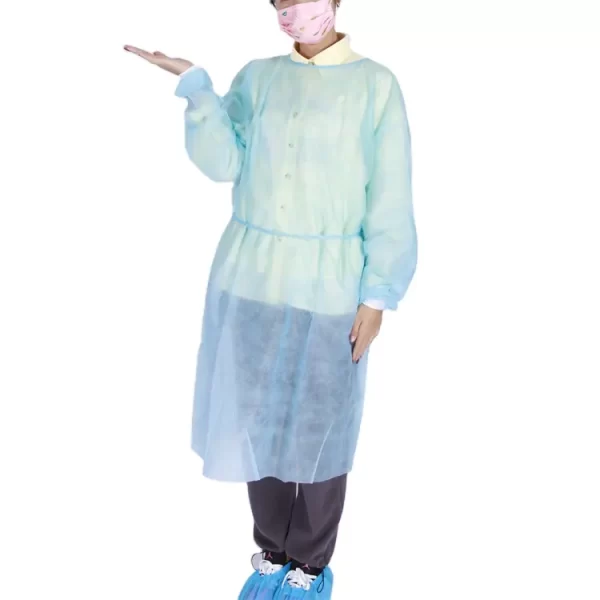How Nonwoven Isolation Gowns Improve Patient Safety
Introduction
In the realm of healthcare, patient safety is a top priority. One of the key elements that contribute to patient safety is the use of personal protective equipment (PPE), including nonwoven isolation gowns. These gowns serve as a critical barrier between healthcare workers and patients, helping to prevent the spread of infections. This article explores how nonwoven isolation gowns contribute to patient safety in healthcare settings.
Understanding Nonwoven Isolation Gowns
Nonwoven isolation gowns are made from nonwoven materials, which are fabrics that are not woven or knitted. Instead, they are produced by bonding or interlocking fibres or filaments mechanically, thermally, or chemically. This unique manufacturing process gives nonwoven materials several advantages over traditional woven or knitted fabrics.
Nonwoven materials are engineered to provide specific properties such as absorbency, resilience, stretch, softness, strength, flame retardancy, washability, cushioning, filtering, bacterial barriers, and sterility. These properties are often combined to create fabrics suited for specific jobs, while achieving a good balance between product use-life and cost. They can mimic the appearance, texture, and strength of a woven fabric, and can be as bulky as the thickest paddings.
The Role of Nonwoven Isolation Gowns in Patient Safety
Infection Control: Nonwoven isolation gowns provide an effective barrier against the transmission of microorganisms and infectious diseases. By wearing these gowns, healthcare workers can prevent the spread of pathogens, protecting both themselves and their patients.
The nonwoven fabric used in isolation gowns is often coated or treated with a variety of substances to make it impervious to liquids and aerosols. This is a critical feature in medical settings where exposure to bodily fluids, bloodborne pathogens, and other infectious substances is common.
Cross-contamination Prevention: Many nonwoven isolation gowns are designed for single use, which eliminates the risk of cross-contamination that can occur with reusable gowns. After use, they can be safely discarded, ensuring that pathogens are not inadvertently spread within the healthcare facility.
This single-use nature is particularly beneficial in situations where a patient has a highly infectious disease, as it reduces the risk of that disease being transmitted to other patients or healthcare workers.
Patient Comfort and Dignity: Nonwoven isolation gowns are not only functional but also comfortable. They are lightweight, breathable, and soft, which can enhance the patient experience. Furthermore, they provide coverage and privacy, helping to maintain patient dignity during their hospital stay.
Nonwoven isolation gowns are designed to withstand the rigors of a healthcare environment. They can endure the physical stresses of patient care, including lifting, moving, and transporting patients, without compromising the integrity of the gown.
Furthermore, the breathability of nonwoven materials helps to reduce heat stress and discomfort, particularly during long procedures or shifts. This can enhance the performance and productivity of healthcare workers by ensuring they remain comfortable and focused on their tasks.
The production of nonwoven fabrics is a high-speed, low-cost process compared to the production of woven fabrics. This results in a lower cost per gown, which can translate into significant savings for healthcare facilities. Additionally, the single-use nature of nonwoven isolation gowns eliminates the costs associated with laundering reusable gowns, further enhancing their cost-effectiveness.
Conclusion
Nonwoven isolation gowns play a crucial role in maintaining patient safety in healthcare settings. Their ability to provide effective barrier protection, prevent cross-contamination, and enhance patient comfort and dignity makes them an invaluable tool in healthcare. As the healthcare industry continues to evolve, the importance of nonwoven isolation gowns in patient safety is likely to grow even further.
The future of nonwoven isolation gowns is promising, with ongoing research and development aimed at improving their performance and sustainability. As we continue to navigate the challenges of healthcare in the 21st century, these gowns will undoubtedly play a crucial role in protecting our healthcare workers and patients alike.
Innovation in the nonwoven industry is expected to lead to the development of new materials and designs that further enhance the protective qualities of isolation gowns. For instance, advancements in nanotechnology could lead to the creation of nonwoven fabrics with even greater barrier protection against microorganisms and fluids.
Moreover, as the healthcare industry continues to grapple with the environmental impact of disposable PPE, we can expect to see more sustainable solutions in the realm of nonwoven isolation gowns. This could include the development of biodegradable nonwoven materials or more efficient recycling processes for used gowns.
In conclusion, nonwoven isolation gowns are a critical component of patient safety in healthcare settings. Their unique properties and benefits, coupled with the ongoing innovation in the nonwoven industry, make them an indispensable tool in the quest to provide safe, high-quality care for all patients. As we look to the future, it’s clear that nonwoven isolation gowns will continue to play a vital role in the ever-evolving landscape of healthcare.
Please visit our website for more product details https://medposnonwoven.com/product/pp-nonwoven-isolation-gowns/

